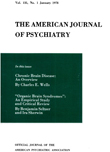ELECTROENCEPHALOGRAPHIC STUDIES IN IDIOPATHIC EPILEPSY, IDIOPATHIC SYNCOPE AND RELATED DISORDERS IN A U. S. NAVAL HOSPITAL
Abstract
1. The physiological and psychological factors relating to idiopathic syncopal attacks are discussed since this symptom was predominant in the group discharged with non-epileptic diagnoses.
2. The symptoms produced by arresting cerebral circulation in man (4) and the syncopal attacks observed in certain cases of personality disorder and psychoneurosis are compared.
3. The ultimate discharge diagnosis and EEG correlation were considered in 469 patients admitted with a diagnosis of epilepsy or a possible convulsive disorder and analysis showed that less than half were discharged from the naval service with a diagnosis of epilepsy and that the EEG abnormalities were significantly higher in this group.
4. Of 469 cases admitted with the possibility of a convulsive disorder 147 were discharged with a diagnosis of personality disorder and 62 with the diagnosis of psychoneurosis which made up about 44% of the admission group.
5. Analysis of 206 cases discharged from a U. S. naval hospital with a diagnosis of epilepsy is presented. The EEG findings are compared with a control group. There is a similarity between Gibbs' series of EEG findings in 730 adult epileptics and with his series of "controls."
6. Nineteen cases or 9.6% of the series gave a history of head injury 1 to 10 years prior to their first convulsive seizure. Of these 19 cases 11 had abnormal EEG, 5 of which were focal in type.
7. Of this series 127 patients had been observed in typical grand mal seizures, and of this group 63% had greatly abnormal EEG and 11.8% showed slightly abnormal EEGs.
8. Typical petit mal histories in this series were rare as were typical petit mal waves in the EEG tracings. A possible explanation for this may be that all of the patients considered were over 17 years of age and 90% of them were in the age group of 17-30 years; the remaining 10% were over 30 years of age.
Access content
To read the fulltext, please use one of the options below to sign in or purchase access.- Personal login
- Institutional Login
- Sign in via OpenAthens
- Register for access
-
Please login/register if you wish to pair your device and check access availability.
Not a subscriber?
PsychiatryOnline subscription options offer access to the DSM-5 library, books, journals, CME, and patient resources. This all-in-one virtual library provides psychiatrists and mental health professionals with key resources for diagnosis, treatment, research, and professional development.
Need more help? PsychiatryOnline Customer Service may be reached by emailing [email protected] or by calling 800-368-5777 (in the U.S.) or 703-907-7322 (outside the U.S.).



